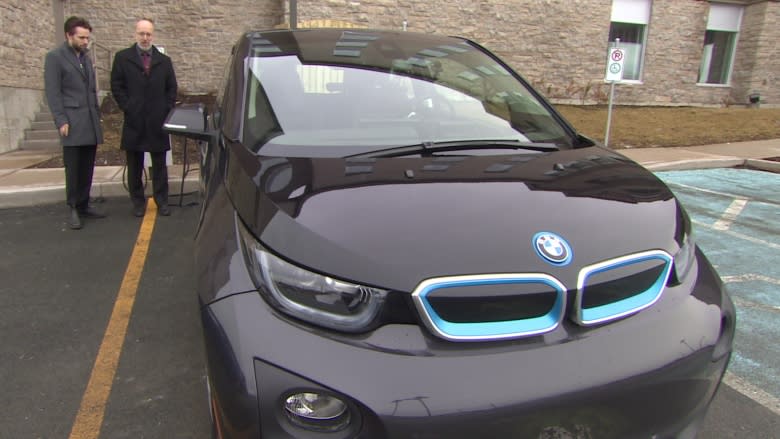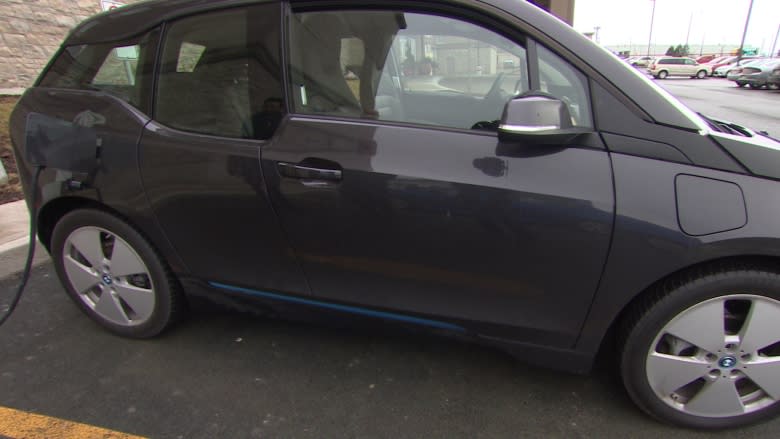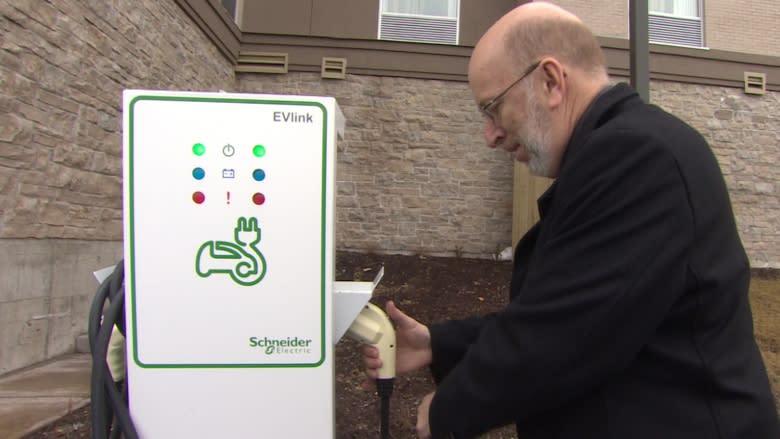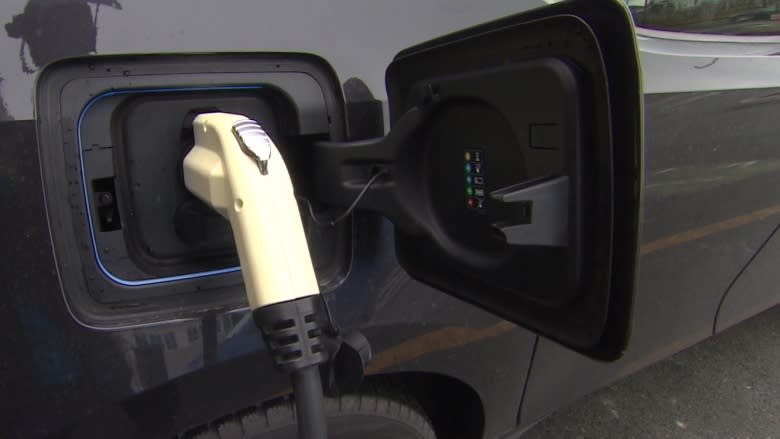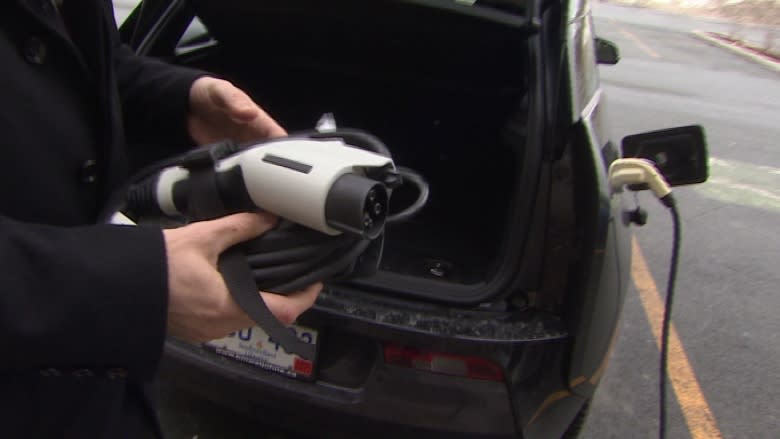It's electric! Environment minister's BMW reduces carbon footprint, sets example
The newest electric car in Newfoundland and Labrador belongs to the new minister of Environment and Conservation, Perry Trimper.
Under Trimper's new portfolio, he's also responsible for climate change and energy efficiency.
To do his part to reduce emissions and demonstrate that electric vehicles can work in this province, he has purchased a BMW i3, the first one to be sold in Atlantic Canada.
He keeps it in St. John's, where he spends much of the year away from his district of Lake Melville.
According to BMW, the i3 is made of carbon fibre and weighs much less than most vehicles. It has a range of 160 kilometres and takes about four hours to recharge with a special 240-volt charger, or 12 to 14 hours with a regular household electrical outlet.
The CBC's Peter Cowan went for a ride with Trimper to find out how the vehicle performed and had several questions for him along the way.
"Welcome to the world of electric vehicles — it's just a matter of hitting the drive and away we go," said Trimper.
Why did you decide to buy an electric car?
Embracing the role as minister of environment and conservation and also on climate change and energy efficiency, I thought 'here's an opportunity to assist with the attitude shift with the momentum that's going on across the continent' ... and this vehicle when I operate it — there are zero emissions coming out of anywhere.
A normal car ... with their internal combustion engines, there's 3.8 tonnes of greenhouse gas emissions coming out of each of those vehicles, each year. So by shifting to more and more electric vehicles, we're all doing our own part … we're all making a contribution to this big national commitment and international commitment we have on climate change.
What does a vehicle like this cost?
This is an expensive one, it's in excess of $50,000 dollars … there's quite a range of vehicles available now. Green Rock EVS, the first dealer that we have in the province ... sells used EV's and you can pick these up in the vicinity of $15,000, $20,000 dollars and on up … then there are really nice high end models like Tesla's that are getting into six figures, so there's the wide range.
The good news of course, while you pay a little bit more for an electric vehicle, you save in its operations. For example, over a 100 kilometre trip, if you actually calculate the amount of electricity versus the gas and so on, it's about 20 per cent of the saving over 100 kilometres — so I'm going to, over time, recoup my initial investment.
The hotel that I'm staying in … they have a charging station, they allow their clients to charge for free, and it's great for me because I don't have any more gas receipts to hand in with a rental car. I did want to get my own vehicle down here so I said, 'let's spend a little bit more money and we'll go electric'.
Doesn't the value proposition change a lot now with the price of gas being where it is and with the price of electricity set to increase substantially?
Look at how gas is also fluctuating. We were just at a point in recent memory, where gas was extremely expensive. Electricity is here to stay and the technology continues to go forward with great advancements and colder weather climates, greater ranges and nice vehicles like this one. So, I think that the arguments around the price of gas being at a low point right now is a short term situation versus the longer term vision as to where the country needs to go.
Why do you think the adoption rates are so low here in Newfoundland and Labrador, when you look at other provinces where they're selling thousands of these and this province where there's just a handful?
First of all you need infrastructure, so the ranges are being developed in each vehicle. This one, as I said, has a range, just on electrical charge, of 135 kilometres. So I need to make sure if I'm going 130 kilometres that I have a station before I get to my last 5 [kilometres].
The good news is that ...we have 47 charging stations now across the island so electric vehicle owners are merrily driving back and forth across the island now using electricity only. We're getting started and the infrastructure is coming along. Because of the way our population is distributed of course it's most efficient here in St. John's where we actually have several stations around the city.
What's the car like to drive compared to a similar car of this size?
The big difference in it is that I almost never have to hit the brake. The way the accelerator is designed is that as I even release on it, it's almost feels like your driving a tractor, like a hydro-static, I hold the brake now as I'm parked but as I slow down ... the batteries are being charged with the friction that comes just from slowing down.
One of the big concerns from people is range and the issue of having to recharge it. Is it really practical in a province that is so spread out ... to have to stop along the way and it's not like a gas station ... you've got to sit there for maybe up to an hour in order to get enough charge to make it to the next station?
I'm just thinking back to my time in Labrador and just thinking how I used to live in community that had no road access … when we could, we would travel with extra gas cans, sleeping bags, shovels in case we got into trouble so there was a lot more preparation that used to be associated with a trip across Labrador. Similarly with the electric vehicle market and what's going on in this province, the infrastructure is starting to come, it's giving people more and more confidence that they can do this.
There are sort of three kinds of charging stations. This vehicle can actually be plugged into a household outlet. It's going to take a lot longer to charge up. A normal one is 120 volts, we're going to a charging station that puts electricity into this system at 240 volts [Level 2] and then finally — your higher end charging stations [Level 1], they're at 480 volts and at 480 volts you can charge up in about 30 minutes.
As you go up, of course in your levels, they're more expensive to install but nevertheless, with demand they will become economically viable. We don't have any of these Level 1 charging stations yet in the province but we certainly have, as I said, almost 50 of these Level 2's. They're quite efficient, in a couple of hours I can have a full charge again.
A lot of other provinces for example, Ontario and recently British Columbia offer fairly substantial incentives in order to encourage people ... should Newfoundland and Labrador be offering incentives for people to buy electric cars?
We're certainly looking at a whole range of options. Our department for climate change and energy efficiency just put a report in November that documents the current status of electric vehicles in the province and looked at other jurisdictions and means of [incentives for] the public to move in this direction.
Financial consideration certainly is something that we're looking at. We're going to be a little fiscally challenged. We've got this deficit to deal with but there are other ways to change attitudes and things that we can do policy-wise that can make it more attractive for people to go and do this.

